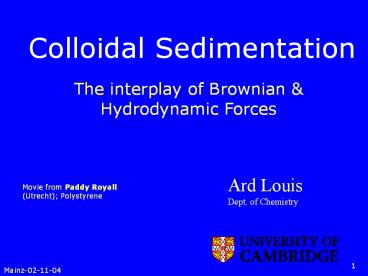Colloidal%20Sedimentation - PowerPoint PPT Presentation
Title:
Colloidal%20Sedimentation
Description:
Movie from Paddy Royall (Utrecht); Polystyrene. The interplay of Brownian & Hydrodynamic Forces ... G.K. Batchelor, J. Fluid Mech. 52, 245 (1972) Hydrodynamic ... – PowerPoint PPT presentation
Number of Views:183
Avg rating:3.0/5.0
Title: Colloidal%20Sedimentation
1
Colloidal Sedimentation
The interplay of Brownian Hydrodynamic Forces
Ard Louis Dept. of Chemistry
Movie from Paddy Royall (Utrecht) Polystyrene
2
Sedimentation of colloids
The bigger the particles the faster they sediment
3
(No Transcript)
4
Sedimentation
Brownian Dynamics 240 discs in a closed container
Pe10
5
Hydrodynamic forcesare long-ranged
- G.K. Batchelor, J. Fluid Mech. 52, 245 (1972)
6
Sedimentation
Hydrodynamics? 240 discs in a closed container
200,000 small fluid particles to generate
Brownian and hydrodynamic forces Hydrodynamics
induces correlated velocity fluctuations
Pe10
7
Hydrodynamic fluctuations?
8
Hydrodynamic Screening?
- Still a mystery!
- Walls on sides?
- Wall at bottom?
- Stratification?
- Noise induced phase transitions?
Segre et al. PRL 79,2574 (1997)
9
What about Mr Brown?
Brownian and Hydrodynamic fluctuations? Thermal
v.s. non-thermal noise?
10
The problem
Colloid
Solvent molecule
- Colloids gtgt solvent molecules
- Stupendous amount of solvent molecules E.g 1011
water molecules per R1 micron colloid. - Coarse-graining is necessary
11
Computational methods
- Stokesian Dynamics (SD)
- Dissipative Particle Dynamics (DPD)
- Lattice Boltzmann (LB)
- Stochastic Rotation Dynamics (SRD)
12
Stokesian Dynamics
- Approximate solution of Stokesequation for many
spheresin a solvent (Oseen tensor) - No explicit solvent
- Only correct at low densities of spheres
- Only correct in the bulk
- Non-spherical particles extremely difficult
- Relatively expensive
- J.F. Brady and G. Bossis, Ann. Rev. Fluid Mech.
20, 111 (1988)
13
Dissipative Particle Dynamics
- Each DPD particle representsa group of solvent
molecules - Pairwise conservative forces
- Pairwise friction random forces
- Conservation of momentum(unlike traditional
Brownian Dynamics) - R.D. Groot and P.B. Warren, J. Chem. Phys. 107,
4423 (1997) - See also Sodderman, Dünweg and Kremer, PRE 69,
046702 (2003)
14
Lattice Boltzmann
- Solvent hydrodynamics emergesfrom collisions on
a lattice - Computationally cheap (order N)
- Discretisation problems with boundaries (walls
and colloid-solvent interactions) - Brownian motion does not emerge naturally, but
must be added by hand - A.J.C. Ladd and R. Verberg, J. Stat. Phys. 104,
1191 (2001) - See also Lobaskin Dünweg NJP, 6, 54 (2004) and
Cates et al. JPCM (2004) for ways to include
Brownian forces
15
Stochastic Rotation Dynamics
- a.k.a.Multi-Particle Collision Dynamics
- a.k.a.
- Malevanets-Kapral Method
16
Stochastic Rotation Dynamics
- Solvent hydrodynamics emergesfrom collisions in
coarse-grainedcells - Computationally cheap (order N)
- Particles move in continuous space,so no
discretisation problems - Brownian motion emerges naturally
- A. Malevanets and R. Kapral, J. Chem. Phys. 110,
8605 (1999) - T. Ihle and D.M. Kroll, Phys. Rev. E 67, 066705
(2003) ibid. 066706 (2003)
17
How does it work?
- Represent the solvent by N point-like particles
(SRD particles) - In between collisions, the SRD particles do not
interact with each other (ideal gas)
18
How does it work?
- Streaming step
19
Collision step Coarse-grain the system into
cells Let all SRD particles in a cell collide
with each other
20
Streaming step
21
Collision step Coarse-grain the system into
cells Let all SRD particles in a cell collide
with each other
22
0(N) Coarse-grained collision step
The velocities of SRD particles, relative to the
centre-of-mass velocity of each cell, are rotated
around an angle. momentum and energy are locally
conserved This generates Navier Stokes
hydrodynamics
23
Many parameters!
A different random rotation axis for each cell
- SRD mass m
- Rotation angle a
- Cell size a
- Average density g
- Temperature kT
- Collision interval dt
24
Adding Colloids
System can be viewed as a 2-component MD scheme
WCA (hard sphere like)
25
Physically important parameters?
SRD particles are not individual molecules they
are a Navier Stokes solver with thermal noise
26
Physically important timescales?
Solvent relaxation time tf10-14
Brownian relaxation time tBm/g10-9
Diffusion time tDR2/Dgtgt tB
Whats important is that they are separated If
tfSRD time-step then tB20 tf
tD2000 tf
27
Simulation of 3D sedimentation
- a/R was varied and tested with full velocity
field around single colloid a/R2 gives 2
error - Hydrodynamic radius the same as from friction
- N8 to 800 colloids
- 500,000 SRD particles
- 3-D Box p.b.c. LxLx14 R, Lz42 R
- From 200 to 30,000 Stokes times tS
28
Average Sedimentation velocityinfluence of
Brownian forces
29
Average Sedimentation velocityinfluence of
Brownian forces
30
Average Sedimentation velocityinfluence of
Brownian forces
31
Average Sedimentation velocityinfluence of
Brownian forces
32
Average Sedimentation velocityinfluence of
Brownian forces
33
Spatial correlations
Swirls?
34
Spatial correlations
Scaled with (vsed)2 Swirls are dominated by
hydrodynamics
35
Temporal CorrelationsBrownian timescales
36
Temporal CorrelationsHydrodynamic timescales
37
3-D sedimentation
See J.T. Padding and A.A.L, cond-mat/0409133 or
PRL (to appear)
- Average sedimentation velocity is dominated by
hydrodynamics even for very small Pe (is this
surprising?) - Short time fluctuations dominated by Brownian
forces, but long time fluctuations by
hydrodynamics for a wide range of Pe (ex of
Pe30000) - For Pegt5 long time non-equilibrium fluctuations
behave just like infinite Pe limit - Neither Brownian nor hydrodynamic interactions
can be ignored
38
Other fun things to try?
- We now have a flexible method to do simulations
39
Example 1 (Nc 2)
Pe 8
Pe 40
40
Example 2
- Sedimentation of 1024 (2D) spheres at high
concentration in a system with periodic
boundaries - Reminiscent of Rayleigh-Taylor instability
Pe 40
41
Example 3 Lane formation
Pe 50 Brownian Dynamics
Pe50 SRD
42
Credits
- Person who did the work
- Dr. Johan Padding
- Details of sedimentation cond-mat/0409133 to
appear PRL (2004) - www-louis.ch.cam.ac.uk
- For more stuff if youd like to join us
- Thank you for listening
43
(No Transcript)































